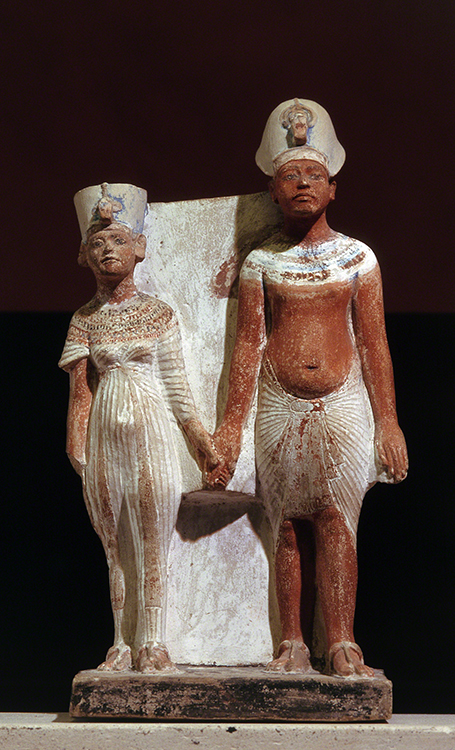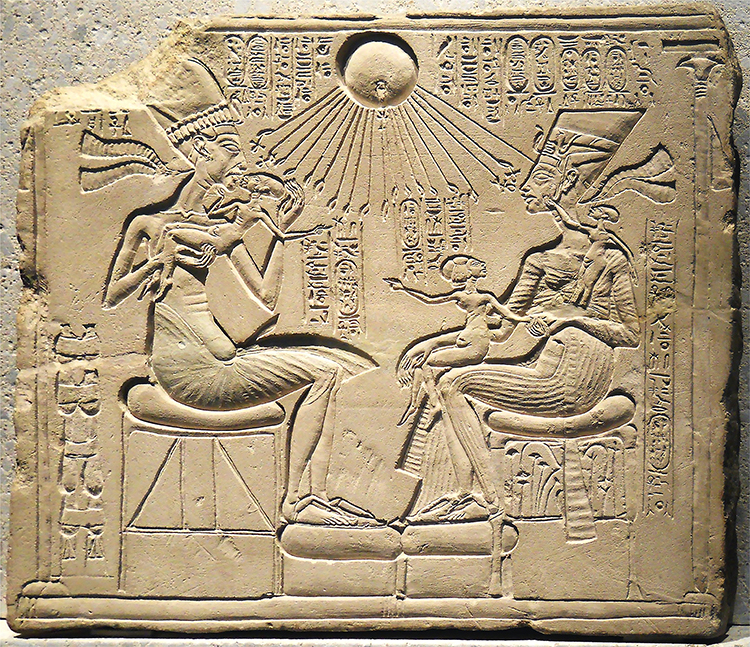Valentine's Day 2023: Akhenaten and Nefertiti
Because I’m a sentimental sap, this post is going to celebrate Valentine’s Day (with works of art, naturally). Presenting 2023’s Valentine’s Day couple in art: Akhenaten and Nefertiti. All the artworks of this couple paint a picture of a happy, family-oriented pair.
 |
| Ancient Egypt, New Kingdom, Dynasty XVIII, Akhenaten and Nefertiti, found at Amarna, 1345–1337 BCE. Painted limestone, 8 ¾" x 4 7/8" x 3 7/8" (22.2 x 12.3 x 9.8 cm). Musée du Louvre, Paris. Photo © 2023 Ron Wiedenhoeft/Saskia Ltd. (JEC-0117) |
While Egyptian pharaohs had more than one wife, they always had a chief queen. Nefertiti (Neferneferuaten, ca. 1367/1363–1330s BCE) was called the “great royal wife” of Akhenaten (Amenhotep IV, died 1334 BCE) in inscriptions. Akhenaten was a pharaoh who turned ancient Egypt upside down when he banned the worship of all but the sun god, Amun Re, or Aten—a time referred to as the Amarna Period. He presented himself as a god-pharaoh, the manifestation of Aten on earth.
It is unclear exactly why, but the centuries-old Egyptian artistic canon was markedly relaxed during the Amarna Period, characterized by an informality and intimacy that was only vaguely hinted at in earlier Egyptian art. This sculpture, probably used for veneration of the god-pharaoh in a household shrine, reflects these unusual changes in Egyptian art. Rather than the stiff, stylized display of affection between a couple—usually in the form of an arm around the waist and hand on hip or shoulder—this sculpture is remarkably informal in the holding of hands. While the faces do not resemble the large sculptures of Akhenaten and Nefertiti, these figures display aspects typical of the Amarna style that Akhenaten’s reign introduced: the shortened torso, narrow shoulders, swollen bellies, wide hips, and skinny arms. Also notable is that the queen is represented only slightly shorter than the pharaoh, instead of being treated hierarchically.
Nefertiti must have had a powerful presence and influence during Akhenaten’s reign. The fact that the queen would be included in household worship indicates that Nefertiti shared Akhenaten’s status as a representative of the sun god, another novelty in Egypt at that time in the New Kingdom (ca. 1550–1070 BCE). In fact, more images remain of Nefertiti than any other ancient Egyptian queen. It is even postulated that she may have ruled alone for a brief period after Akhenaten’s death, although that has not been proven for certain.
Egypt's geographic location ensured that its culture, religious beliefs, and forms of art remained substantially unchanged for more than 3000 years. The deserts to the west and east, the Mediterranean Sea to the north, and the Nile, which runs the length of the eastern part of the country, all protected Egypt from invasion. Despite the arid climate, the Nile's annual flood (usually August) deposited rich soil on the river's bordering fields, producing rich farmland for abundant and varied crops.
Religion in Egypt remained little changed throughout Egypt's history until the second third of the New Kingdom's Eighteenth Dynasty (1539–1395 BCE). Shortly after the reign of Amenhotep IV began around 1351 BCE, the pharaoh changed his name to Akhenaten and forced the worship of only the god of the solar disk, Aten. The traditional pantheon of gods was ignored, their temples closed, and their priests forced to convert. Akhenaten built a city in the Middle Nile dedicated to Aten's worship called Amarna.
 |
| Ancient Egypt, New Kingdom, Dynasty XVIII, Akhenaten, Nefertiti and Three Daughters, ca. 1340 BCE. Limestone, height: 12 13/16" (32.5 cm). Ägyptisches Museum und Papyrussammlung der Staatlichen Museen zu Berlin - Preußischer Kulturbesitz. Photo © David Holt. CC BY-SA 2.0. (APAH-022) |
Nefertiti and Akhenaten had six daughters together. One of them, Ankhesenamun (ca.1348/1342–after 1322 BCE), was the wife of Akhenaten’s successor, Tutankhamun (died 1323 BCE). Tutankhamun was Akhenaten’s son by “the younger lady,” indicating one of the “lesser” consorts of the pharaoh.
In the relief above, Akhenaten and Nefertiti have familial moment with three of their daughters. The pharaoh kisses one daughter, another is held by Nefertiti, while the third plays with Nefertiti's earring. This type of intimate family interaction was unheard of in previous reliefs of the royals of Egypt. Again, this relief comes from a family household shrine, so Akhenaten and Nefertiti are both objects of worship as divine beings, emphasized by the Aten’s life-giving rays bathing them.


Comments